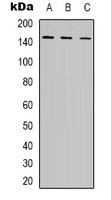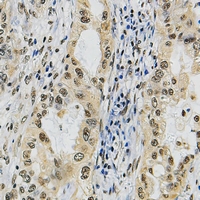

| WB | 咨询技术 | Human,Mouse,Rat |
| IF | 咨询技术 | Human,Mouse,Rat |
| IHC | 1/50-1/100 | Human,Mouse,Rat |
| ICC | 技术咨询 | Human,Mouse,Rat |
| FCM | 咨询技术 | Human,Mouse,Rat |
| Elisa | 咨询技术 | Human,Mouse,Rat |
| Aliases | DNA-directed RNA polymerase III subunit RPC1; RNA polymerase III subunit C1; DNA-directed RNA polymerase III largest subunit; DNA-directed RNA polymerase III subunit A; RNA polymerase III 155 kDa subunit; RPC155; RNA polymerase III subunit C160 |
| Entrez GeneID | 11128; |
| WB Predicted band size | 156kDa |
| Host/Isotype | Rabbit IgG |
| Antibody Type | Primary antibody |
| Storage | Store at 4°C short term. Aliquot and store at -20°C long term. Avoid freeze/thaw cycles. |
| Species Reactivity | Human,Mouse,Rat |
| Immunogen | KLH-conjugated synthetic peptide encompassing a sequence within the N-term region of human POLR3A. |
| Formulation | Purified antibody in PBS with 0.05% sodium azide. |
+ +
以下是关于POLR3A抗体的3篇参考文献,包含文献名称、作者及摘要概括:
---
1. **文献名称**: *Mutations in POLR3A and POLR3B Encoding RNA Polymerase III Subunits Cause an Autosomal-Recessive Hypomyelinating Leukoencephalopathy*
**作者**: Bernard G. et al.
**摘要**: 该研究通过全外显子测序发现,POLR3A和POLR3B的突变导致常染色体隐性遗传的髓鞘发育不良性脑白质病。研究利用POLR3A抗体进行Western blot和免疫组化,证实突变导致RNA聚合酶III亚基表达水平下降,影响髓鞘形成。
---
2. **文献名称**: *RNA Polymerase III Subunit Mutations in Genetic Diseases*
**作者**: Wolf N.I. et al.
**摘要**: 本文综述了POLR3A等RNA聚合酶III亚基突变相关的神经退行性疾病。研究通过POLR3A抗体的免疫荧光实验,展示了突变细胞中POLR3A蛋白的异常定位,提示其与细胞核内转录功能受损相关。
---
3. **文献名称**: *Antibody Validation and Immunodetection of RNA Polymerase III Subunits in Human Cells*
**作者**: Dumay-Odelot H. et al.
**摘要**: 该文献系统验证了多种RNA聚合酶III亚基抗体的特异性,包括POLR3A抗体。通过siRNA敲低实验和质谱分析,证实了该抗体在免疫沉淀(IP)和免疫印迹(WB)中的高特异性,为后续功能研究提供了可靠工具。
---
这些文献分别从疾病机制、功能验证和抗体应用角度,展示了POLR3A抗体在基础研究与临床诊断中的应用。如需更多文献,可进一步限定研究领域或年份。
The POLR3A antibody targets the RNA polymerase III subunit A (POLR3A), a critical component of the RNA polymerase III enzyme complex. RNA polymerase III is responsible for transcribing small non-coding RNAs, including transfer RNAs (tRNAs), 5S ribosomal RNA (5S rRNA), and other regulatory RNAs essential for protein synthesis and cellular homeostasis. POLR3A, also known as RPC1. forms the largest catalytic subunit of the complex and plays a pivotal role in transcription initiation and elongation.
Mutations in the POLR3A gene are linked to several neurological disorders, notably hypomyelinating leukodystrophies such as 4H syndrome (hypomyelination, hypodontia, hypogonadotropic hypogonadism), characterized by impaired myelin formation in the central nervous system. Research using POLR3A antibodies has been instrumental in elucidating the molecular mechanisms underlying these conditions, including disrupted RNA synthesis and cellular stress responses.
POLR3A antibodies are widely employed in molecular biology and clinical research for applications like Western blotting, immunohistochemistry, and immunofluorescence to detect protein expression levels, localization, and interactions. They are also used to study POLR3A's role in diseases beyond leukodystrophies, such as cancer and neurodegenerative disorders. Specificity and validation of these antibodies are crucial, as cross-reactivity with other polymerase subunits can occur. Recent studies further explore POLR3A's involvement in aging and viral infection responses, highlighting its broad functional relevance.
×